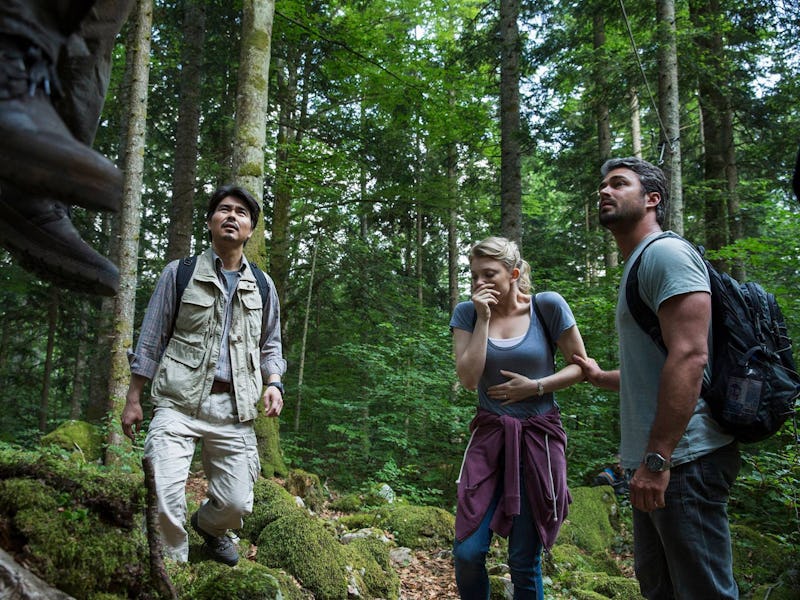The Dank Shroomadelic Banality of the Natalie Dormer-Starring 'The Forest'
The new Natalie Dormer horror film, set in Mount Fiji's 'suicide forest' in Japan, is a strange, offensive, and occasionally visually inspired fast ride.

Most people who have seen the trailer for the new Natalie Dormer star feature and ghoul-filled B-horror offering The Forest probably feel like they have a pretty good idea of its content, trajectory and vibe. Their expectations will be proved correct. Those whose understanding of the movie stems from the snowballing accusations of “whitewashing” and cultural insensitivity will unfortunately, also be validated. The movie — directed by relative newcomer Jason Zada — is, unfortunately, heavily steeped in your textbook exoticism, mining the “otherness” of Japanese culture for scares largely functionally unrelated to the movements of the plot.
The first act of the movie digs right into it, while laying out the totally boilerplate premise: An American woman, Sara Price (of all names) — job and human sentience unclear — travels to Japan to find her twin sister, who has gone missing there. This is hashed out in the course of a swift montage, showing her journey, and even a meaningless flashback in which Dormer plays both sisters. As Zada guides us through this, plenty of Japanese citizens freak out Sara — whose plane has just landed — with no subtitles to decrypt their actions. Note, especially, the wild-eyed elderly (homeless?) man who slaps ominously on her cab window. The big lights of Japan flit over Dormer’s vacant eyes like they did is Scarlett J.’s [oh-so-many years ago now](https://en.wikipedia.org/wiki/Lostin_Translation(film). All of this is — in a word — shameless.
Once she gets to the forest itself — the very real Aokigahara “suicide forest” — the Creepy Japanese People Dormer expects to wait on her crop up in more and more sinister guises. A savior, brawny white guy (Taylor Kinney) shows up — Aiden, a travel journalist living in Tokyo and writing for an Australian magazine (?) — to help Sara find her way around the forest. That is, with the help of a mystical Japanese tour guide (Yukiyoshi Ozawa)! As our understanding of Sara’s sister builds — man, she was just so troubled…about nothing! She read poetry! — the film’s casual cluelessness about the nature of mental illness is revealed. It’s not that we should expect depth from a horror movie working on the utmost surface of things, but perhaps a modicum of good taste.
Aiden (Taylor Kinney) and Sara (Natalie Dormer), pensive
Insofar as there is something formally interesting about this film, it is the druggy, hallucinatory switch-ups it plays in the midst of the forest. There is some fun visual trickery — for instance, Sara and Aiden’s split vision of the direction of a river’s current — and earlier, unreliable narration pitted against a flashback. Sara is no match for the mystical power of Aokigahara; she loses all track of reality. Paranoia ramps up. She believes Aiden is an impostor, and out to kill her and her sister. Meanwhile, the trees and moss around her breath creepily, and colors distort subtly. Yes, it’s a very rote and even kinda subtle portrayal of poison shroom consciousness (what have you been getting up to, Zada?) The filmmakers built up several different twist possibilities in the context of Sara’s descent into madness — among them, the possibility that Aiden is a ghostly deception, and the possibility that Sara has invented her twin sister.
Without spoiling it, ultimately the final twist is executed well, but is underwhelming. This is partially the result of pacing. The movie ends so abruptly it seems like the filmmakers forgot to include a whole final act. But the brevity of The Forest is key to the knee-jerk horror-fan appeal it carries off in its body. Thankfully, it breezes weirdly through its worst section, and doesn’t double down too hard with mining characters that inherently have nothing original to offer. This film is a simple project — a short ride in a decently fast machine — and if you can get past how tone deaf the baseline race and gender politics are, you can sit back to jump and chuckle at the appropriate, non sequitur scares.